ASCENDO C8 RENAISSANCE LOUDSPEAKER
| ASCENDO C8 RENAISSANCE LOUDSPEAKER |
| Beauty conquers Brawn |
|
|
|
May 2008 |
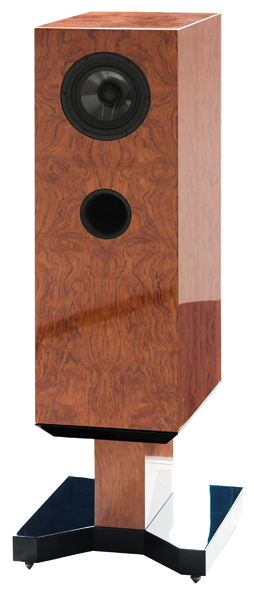
Short Story: (A few weeks in the life)
Week One: Delivery, easy setup, no fuss, fit and finish are first class. Did some non-critical listening. Sounded pretty good. Voices were already sounding better than expected and rivaled my VR5SEs.
Week Two: After leaving system on all day, C8s sounded a bit more open. However, the soundstage just wasn’t quite there yet.
Week Two/Three: System mostly left on with music playing. No critical listening.
Week Three/Four: Voices and brass instruments sound lifelike. Very good soundstaging.
Week Four: Soundstaging has exploded through the walls. Is this natural?
Week Four/Five: Imaging and voices were so real I became frightened.Thought a live person was going to jump out of the C8s at me.
How it all began
The 2007 Rocky Mountain Audio Fest (RMAF) was quite an event. If you had the distinct pleasure to attend, then you know exactly what I’m talking about. I had the time of my life, hanging out with fellow Stereo Timers Clement Perry and Bill Wells. I was given the opportunity to hang with them for a day to observe and learn many things from these experienced listeners. We visited many exhibits and listened to a plethora of audio components, tweaks, acoustical products, etc. For two entire days, I was in audio heaven. I really can’t honestly say that all rooms made an impression on me, however, one thing I can say is that there was one room that stood out among all others, and that was the Ascendo/Behold room. This room housed the Behold Audio electronics that included their amp/preamp combo, the Nova Physics Memory Player, and last but not least, a pair of the new and beautifully finished Ascendo Model C8 Renaissance loudspeakers. I felt a lasting sonic richness that pierced my inner soul. The sound just had a “rightness” about it that actually reminded me of how music, when done correctly, is supposed to sound. What proved most reassuring is Clement didn’t “ask me” to like this room because it was composed of components he is intensely familiar with and use as his current reference. In fact, it was the other way around. I marveled at these products and knew immediately why Clement took a liking to them and qualifies them as his reference to this day.
As I traveled home from RMAF, on my way back to Wichita, KS, I replayed some of the events of the weekend in my mind. I thought about what had impressed me the most and what would I have changed. Without a doubt, one of the things I would changed and will not do again is book my room on the same side of the hotel where all the exhibits take place. I got no sleep at all. There was music being played until way after 3 AM. Aside from that, it was all worth while, especially since I had the chance to hear so many great components I had never heard of before. I shared my thoughts with Clement the same night I arrived home, expressing how I felt that the Ascendo room, and particularly the Ascendo C8 loudspeakers, were at the top of my list (herein C8 Renaissance).
The beginning of a new era?:
Months later, right after the 2008 CES I received a phone call from Clement asking if I would like to audition/review a pair of C8 Renaissance loudspeakers. In no time flat I graciously accepted, feeling this would be a great opportunity to put these speakers to the test, especially since I already owned a pair of what most (including myself) considered to be a world class loudspeaker: the Von Schweikert Research VR5SE.
About a week later the speakers arrived from New York City based distributor, Laufer Teknik. They arrived in four separate boxes, very well packed. To my surprise they were nowhere close to the weight or size of my VR5SE’s. I was able to handle each separate box without too much trouble. After pulling each 36 kg cabinet out of the box, I was pleasantly reminded of the C8’s eloquent beauty, fabulously finished in rosewood with a super piano lacquer like none other. The fit and finish of this loudspeaker is exceptional. One could tell these were built with a special purpose in mind. Another element that impressed me was the matching stands which were of equal build quality.
Getting down to the basics:
Prior to officially getting started on this particular project, and as a research engineer, I began to do what I do best, conduct some extensive research on these German designed dynamic loudspeakers. I was seeking as much information on the C8s as possible. However, much to my surprise and disappointment, there was hardly anything available. I searched Google and visited many audio forums for feedback. But my only success was the Ascendo website. Well, I guess I will be the first to give a thumbs up or down on the C8 Renaissance C8 Renaissance . So, let’s get it on.
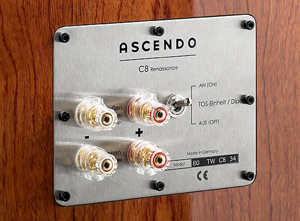 What I found on the website was very enlightening. The entire Ascendo loudspeaker line are manufactured in Koengen, Germany. The C8 Renaissances represent their newer less expensive series and like the bigger Z and M series, are capable of three and four way operation at the flip of a switch (TOS function). I did not get the chance to find out what the acronym (TOS) stood for, but this much I do know, when TOS is “On,” the C8 Renaissance functions in the four-way mode by way of its rear-firing ribbon tweeter. When in the “Off” position, it functions in three-way mode by way disabling the rear tweeter. The “sonic” difference between “On and Off” of the rear ribbon tweeter, is when “On,” and – dependent upon the source material – “produces an authentic musical reproduction and three dimensional spaciousness due to perfect impulse response” stated in their owners manual.
What I found on the website was very enlightening. The entire Ascendo loudspeaker line are manufactured in Koengen, Germany. The C8 Renaissances represent their newer less expensive series and like the bigger Z and M series, are capable of three and four way operation at the flip of a switch (TOS function). I did not get the chance to find out what the acronym (TOS) stood for, but this much I do know, when TOS is “On,” the C8 Renaissance functions in the four-way mode by way of its rear-firing ribbon tweeter. When in the “Off” position, it functions in three-way mode by way disabling the rear tweeter. The “sonic” difference between “On and Off” of the rear ribbon tweeter, is when “On,” and – dependent upon the source material – “produces an authentic musical reproduction and three dimensional spaciousness due to perfect impulse response” stated in their owners manual.
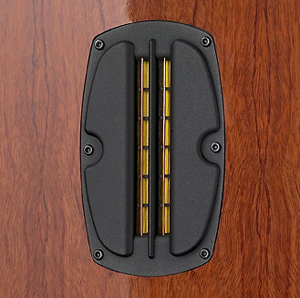 Physically, the Ascendo C8 Renaissance is made with four different drivers: a coaxial mid/bass driver combining a 25mm Neodymium-fabric tweeter with a 18cm woofer with XP cone; a 21cm Kevlar woofer cone housed inside the cabinet unseen to the naked eye (much like their larger Z and M System Clement and Key Kim reviewed), and the rear ribbon-tweeter whose sole responsibility is for ambiance enhancement. The C8 Renaissance can be either single or bi-wired and come with a 10 year guarantee.
Physically, the Ascendo C8 Renaissance is made with four different drivers: a coaxial mid/bass driver combining a 25mm Neodymium-fabric tweeter with a 18cm woofer with XP cone; a 21cm Kevlar woofer cone housed inside the cabinet unseen to the naked eye (much like their larger Z and M System Clement and Key Kim reviewed), and the rear ribbon-tweeter whose sole responsibility is for ambiance enhancement. The C8 Renaissance can be either single or bi-wired and come with a 10 year guarantee.
I am always cautious when either auditioning or reviewing a product in a different location from where I originally heard it. First impressions can be lasting, however I had to keep the different conditions in mind. I was not duplicating the same environment I heard at RMAF. A couple of very important aspects I considered were the room and the associated components while in Denver. I am now dealing with my own room, my own components, so to be fair, I had to try and throw all those past memories out of my mind and proceed with a complete unbiased review. (Just the facts Watson)
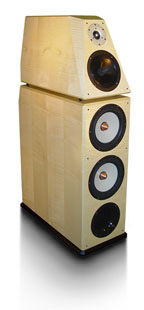 I also had to take into consideration that I lived with the Von Schweikert VR5SEs for the past two years and knew their sound. Ditto my McIntosh 501 mono amps as well. I was convinced beyond a shadow of doubt that the VR5’s would be tough to beat and especially at $22k, going up against a loudspeaker at more than half its asking price. Now don’t get me wrong, this review was not intended to be considered a VR5SE vs. the C8 Renaissance, however let’s be real, I had the VR5SE stamped in my brain for over two years, and they’re my current reference loudspeaker, so there’s bound to be some comparisons.
I also had to take into consideration that I lived with the Von Schweikert VR5SEs for the past two years and knew their sound. Ditto my McIntosh 501 mono amps as well. I was convinced beyond a shadow of doubt that the VR5’s would be tough to beat and especially at $22k, going up against a loudspeaker at more than half its asking price. Now don’t get me wrong, this review was not intended to be considered a VR5SE vs. the C8 Renaissance, however let’s be real, I had the VR5SE stamped in my brain for over two years, and they’re my current reference loudspeaker, so there’s bound to be some comparisons.
I sought the help of my son to remove the VR5SE’s from their respective positions and moved the C8 Renaissances in their place. As I positioned the stands in place, it felt like the stands weighed just as much as the speakers themselves. They were heavy and solid. I felt they provided an excellent foundation for the speakers. I then took time to carefully position the speakers on each stand, measuring approximately 4.6’ from the side walls and 4.33’ from the rear wall of my 13’ x 17’ x 8.5’ listening room. I used the Cardas speaker placement as my guide. I decided not to do any toeing in, at least not from the beginning. Next, I hooked both my MIT Oracle V1.1 bi-wired speaker cables to each well constructed binding posts of the C8 Renaissance. This task was accomplished without a hitch. I then sat back for a moment to admire the beauty of this magnificent display of artistry as it gracefully occupied space in my listening room.
How it all continued:
My plan was to setup the C8s, check to ensure all was well, and run some music through them at low volumes for the rest of the day. I’d come back the next day and do some non-critical listening. However, I don’t know why I lied to myself, I knew when I made those plans there was no way possible I was going to just set up and walk away. I had to know if what I heard at RMAF was an illusion. Was it the $80,000 worth of Behold electronics? Could it have been attributed to the Nova Physics Memory Player? Was it the room acoustics or were these speakers a legitimate factor?
Read on, the answer lies ahead.
My 25 year history with loudspeakers revealed only a few that I have been somewhat impressed with. Up until I purchased the VR5SE, none were considered anywhere close to being considered of reference caliber. I just never owned them long enough or I frequently changed components and they were never given much time to settle in. This was not the case with the VR5SE’s, I owned them for over two years and had not come close to, or even considered changing. So initially, in my mind the review of the Ascendo’s would be just that, “a review.”
The initial listening test came the night of setup. Although I did not intend to do any critical listening I wanted to hear what this speaker was capable of out of the box. Initially, the C8s sounded decent. Top to bottom they were not in VR5SE territory. One particular attribute that caught my immediate attention was the midrange of the C8s: the voices were as clear as a bell. I’m talking about sit up and take notice type of sound. However, keep in mind that was just the tip of the iceberg, especially for what I experienced some weeks later.
The C8 Renaissances definitely needed time to settle down, so I decided to give them time. After days of listening to some of my favorite music, I knew I was on to something special. The more they had time to burn-in, and the more I heard the C8 Renaissances, the more the VR5SEs vanished from my memory. The C8 Renaissances performed better in so many critical areas than the VR5SEs did. This, however, could be the result of room size. In my opinion the C8 Renaissance was built for small to medium sized listening areas like mine. One very important aspect was that the C8 Renaissances controlled my room better than the VR5SEs. I felt the dynamics of the recordings were more right-sized, natural and distortion free. Never did the music become overbearing – regardless of volume. I was not overcome by any sonic abnormalities in any of my favorite recordings, even when played at a higher volume level as the fatigue factor was non-existent. No sibilance or edginess to deal with. Horns and guitars sounded right. An instrument that normally gives me fits is the piano. However, the C8 Renaissances handled them with a certain grace that belied their asking price. The sound overall produced by the C8 Renaissances were simply beyond satisfaction. They were more like therapy.
The C8s has what I consider perfect mid frequency delicacy. With time, as the midrange just kept getting better and better, the highs blended with the midrange in that seldom understood time/phase/coherency manner often written about. This sonic invisible blend resulted in a very wide and holographic three-dimensional soundstage with an incredibly natural feel. Micro and macro dynamic details were easier to decipher due to the (probably inherent) ultra quietness of its high quality coax mid/bass drivers. This quality provided the C8 Renaissances the ability to recognize individual instruments with a much improved sense of realism. In other words, the C8 Renaissances displayed an enormously palpable and lifelike footprint, stretching far beyond and deeper than their physical location. This was also accomplished with the right amount of scale as none of the instruments or vocals seemed larger than life or bloated.
If there was one caveat, one single area I felt the C8 Renaissance needed improvement, it would be in respect to low bass slam. I felt the VR5SEs were much better in the low bass frequencies. But hell, at twice the price and sporting dual 8″ woofers in their own dedicated cabinets they better had been. No, the C8 Renaissance will not go as low as the VR5SEs but they handle the most important part of the story – THE MIDRANGE – so beautifully and with such grace that trading in the lowest bass octaves for the type of communicative spirit the C8 Renaissance possesses made it a no brainer.
This is a classic case of Beauty over Brawn.
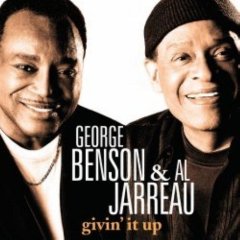 The best way to illustrate my experience with the C8 Renaissance loudspeakers was when I listened to Jill Scott, Al Jarreau, and George Benson as the teamed up to sing “God Bless the Child” from Al and George’s latest CD entitledGivin’ it Up [Monster Cable CD label.] Very seldom have I heard such a blend of talent put together on one song. The C8 Renaissance brought out the velvet tones of Scott and Benson singing, yet didn’t miss a beat with Jarreau’s unusual but sweet monotonic vibrating voice and background improvisations. What really sets this tune off is when Benson offers up a hypnotic guitar solo that caused me to get out of my seat in awe and appreciation of the music on this disc. I was overtaken with joy and amazement at what the C8 Renaissances had just delivered. “Givin’ it Up” is a great recording and as a result was presented with such musical satisfaction that I began to feel as though the system had totally disappeared. In fact, I began referring to this phenomenon as “The Ascendo Houdini Act,” because of their uncanny ability to disappear.
The best way to illustrate my experience with the C8 Renaissance loudspeakers was when I listened to Jill Scott, Al Jarreau, and George Benson as the teamed up to sing “God Bless the Child” from Al and George’s latest CD entitledGivin’ it Up [Monster Cable CD label.] Very seldom have I heard such a blend of talent put together on one song. The C8 Renaissance brought out the velvet tones of Scott and Benson singing, yet didn’t miss a beat with Jarreau’s unusual but sweet monotonic vibrating voice and background improvisations. What really sets this tune off is when Benson offers up a hypnotic guitar solo that caused me to get out of my seat in awe and appreciation of the music on this disc. I was overtaken with joy and amazement at what the C8 Renaissances had just delivered. “Givin’ it Up” is a great recording and as a result was presented with such musical satisfaction that I began to feel as though the system had totally disappeared. In fact, I began referring to this phenomenon as “The Ascendo Houdini Act,” because of their uncanny ability to disappear.
Conclusions…
To sum this all up, I never expected to bring RMAF back to Wichita Kansas. The Ascendo C8 Renaissance is one remarkable loudspeaker, especially for what it delivers for the musical connoisseur rather than the dynamic head-banger. Given their price, first class build quality, beauty and performance, the C8 Renaissance are a fantastic bargain.
The Ascendo C8 Renaissance loudspeaker has changed my way of thinking when it comes to audio purchasing. No longer do I feel it necessary to judge loudspeakers solely on their cost. I would gladly put the C8 Renaissance loudspeaker up against most $20-$30K loudspeakers available. If your listening room is small to medium sized, and you want to fill it with unbelievable, unsurpassable sonic joy, accompanied by a sense of absolute zero distortion capped off by a holographic midrange that’s fully capable of taking your breath away, then it would be worth your while to give these magnificent wonders an audition. Chances are your audition will become a long lived relationship. How can I make such a claim? Well, because it happened to me and I have not looked back since.

![]()
Specifications:
Loudspeaker Model: Ascendo C8 Renaissance
Description: 3-4 way system with inner cabinet bass woofer, coaxial mid/tweeter, and rear ribbon tweeter
Principle: Three-way with SASB bass unit (TOS Off) current damped outer driver with semi-symmetrical band pass
Weight: 36kg
Frequency Response: 29 Hz (-3dB) – 32kHz
Power Rating 350 W
Impedance 6 Ohm
Sensitivity 88 dB/ 1W/m
Chassis (Outer) Coax
25mm Neodymium-fabric tweeter
18cm Woofer with XP cone
Chassis (Inner) 21 cm Chassis, Kevlar cone
TOS Chasssis Ribbon Tweeter
TOS function Switchable
An: TOS unit/Dipole on
Aus: TOS unit/Dipole off
Guarantee 10 Years
Dimensions (W/H/D) 28/80/40 (without base)
28/108/40 (with base)
C8 Base
Weight 14kg
Price $10,000
Made in Germany
Website: http://www.ascendo.de
U.S. Distributor
Laufer Teknik
110 Livingston St #4G
Brooklyn NY 11201
(347) 529-5874
E-mail: slaufer@lauferteknik.com
Web: www.lauferteknik.com
![]()
Don’t forget to bookmark us! (CTRL-SHFT-D)
Stereo Times Masthead
Publisher/Founder
Clement Perry
Editor
Dave Thomas
Senior Editors
Frank Alles, Mike Girardi, Russell Lichter, Terry London, Moreno Mitchell, Paul Szabady, Bill Wells, Mike Wright, and Stephen Yan,
Current Contributors
David Abramson, Tim Barrall, Dave Allison, Ron Cook, Lewis Dardick, John Hoffman, Dan Secula, Don Shaulis, Greg Simmons, Eric Teh, Greg Voth, Richard Willie, Ed Van Winkle, Rob Dockery, Richard Doran, and Daveed Turek
Site Management Clement Perry
Ad Designer: Martin Perry




Be the first to comment on: ASCENDO C8 RENAISSANCE LOUDSPEAKER